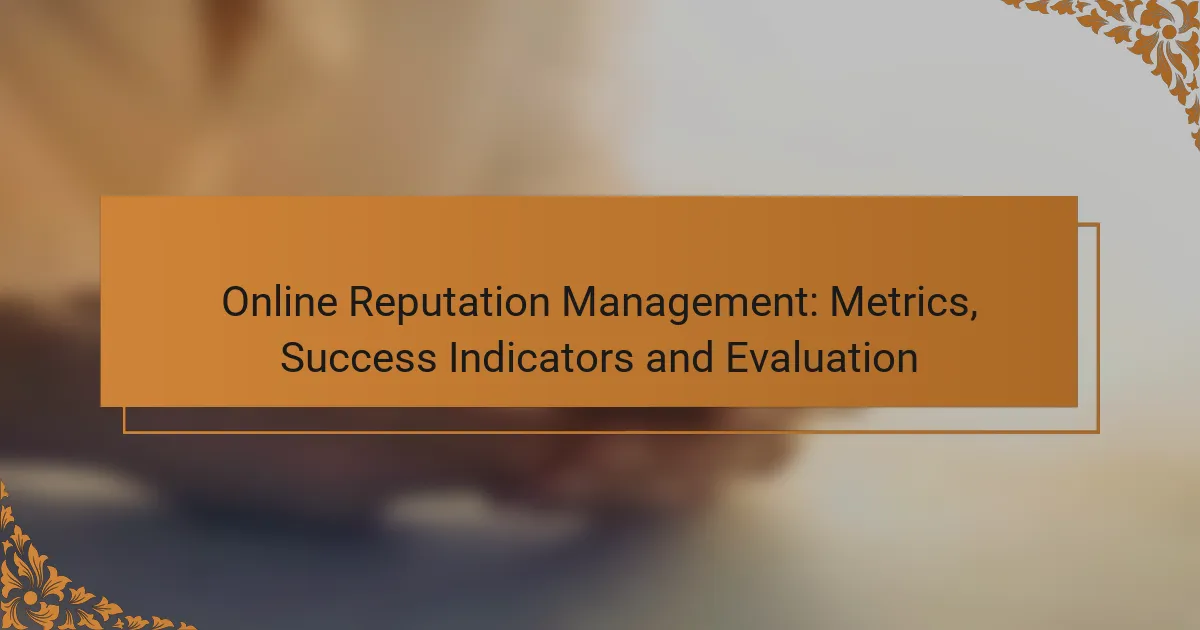Online Reputation Management (ORM) is crucial for businesses aiming to understand and enhance their brand perception in the digital landscape. By analyzing key metrics such as customer sentiment and engagement, companies can gain valuable insights that inform their strategies for improving reputation. Evaluating success in ORM involves monitoring indicators like customer feedback and search engine rankings, which reflect the overall health of a brand’s online presence.

What are the key metrics for online reputation management?
The key metrics for online reputation management (ORM) include various indicators that help assess how a brand is perceived online. These metrics provide insights into customer sentiment, engagement, and overall brand health, allowing businesses to make informed decisions to improve their reputation.
Sentiment analysis score
Sentiment analysis score measures the emotional tone behind online mentions of a brand. This score typically ranges from negative to positive, indicating how customers feel about a brand based on their reviews, comments, and social media posts. A higher score suggests a more favorable perception, while a lower score indicates potential issues that may need addressing.
To effectively use sentiment analysis, consider employing tools that aggregate data from various platforms. Regularly monitoring this score can help identify trends and shifts in public perception, enabling timely responses to negative feedback.
Net Promoter Score (NPS)
Net Promoter Score (NPS) gauges customer loyalty by asking how likely customers are to recommend a brand to others. Scores typically range from -100 to 100, with higher scores indicating a more loyal customer base. A positive NPS suggests that customers are satisfied and willing to advocate for the brand.
To calculate NPS, survey customers and categorize their responses into promoters, passives, and detractors. Regularly tracking NPS can help identify areas for improvement and measure the impact of reputation management efforts over time.
Review volume and ratings
Review volume and ratings reflect the quantity and quality of customer feedback across various platforms. A higher volume of reviews generally indicates a more engaged customer base, while average ratings provide insight into overall satisfaction. Maintaining a steady influx of reviews can enhance a brand’s credibility.
Encourage satisfied customers to leave positive reviews and promptly address any negative feedback. Aim for a balanced review volume across platforms like Google, Yelp, and industry-specific sites to ensure a comprehensive view of your brand’s reputation.
Social media engagement metrics
Social media engagement metrics include likes, shares, comments, and overall interaction rates with brand content. High engagement levels often correlate with a positive brand image, as they indicate that customers are actively participating in conversations about the brand.
Track these metrics using social media analytics tools to understand which content resonates with your audience. Focus on creating engaging posts that encourage interaction, and respond promptly to comments to foster a positive community around your brand.
Brand mention frequency
Brand mention frequency tracks how often a brand is discussed across various online platforms. Increased mentions can signify growing brand awareness or interest, while a sudden drop may indicate potential issues that need to be addressed. Monitoring this frequency helps gauge the effectiveness of marketing efforts and public relations strategies.
Utilize media monitoring tools to keep track of brand mentions in real-time. Analyzing the context of these mentions can provide valuable insights into public sentiment and help identify opportunities for engagement or crisis management.

How to evaluate online reputation management success?
Evaluating online reputation management (ORM) success involves assessing various metrics that reflect customer perceptions and brand visibility. Key indicators include customer feedback, changes in brand perception, and improvements in search engine rankings.
Customer feedback analysis
Customer feedback analysis is crucial for understanding how your audience perceives your brand. This can be done through surveys, reviews, and social media comments. Regularly monitoring platforms like Google Reviews, Yelp, and social media channels can provide valuable insights into customer sentiment.
Look for trends in feedback over time. For instance, if positive reviews increase after implementing a new service, this may indicate effective ORM strategies. Aim for a balanced approach by addressing negative feedback promptly while amplifying positive comments.
Change in brand perception
Change in brand perception can be gauged through brand awareness studies and sentiment analysis. Tools like surveys and social listening platforms can help track shifts in how customers view your brand. A positive change might be reflected in increased brand mentions or a higher percentage of favorable comments.
Consider conducting periodic brand health assessments to measure perception changes. For example, if your brand is perceived as trustworthy, you may see a rise in customer loyalty and repeat purchases. Establish benchmarks to compare pre- and post-ORM efforts effectively.
Improvement in search engine rankings
Improvement in search engine rankings is a key indicator of successful ORM. Higher rankings for branded keywords often correlate with positive online reputation. Use tools like Google Analytics and SEMrush to monitor changes in your website’s position on search engine results pages (SERPs).
Focus on optimizing your content and managing online reviews to enhance your visibility. Aiming for first-page rankings for your brand name can lead to increased traffic and customer trust. Regularly assess your SEO strategies to ensure they align with your ORM goals.

What tools can assist with online reputation management in the UK?
Several tools can effectively assist with online reputation management in the UK, helping businesses monitor and enhance their public image. These tools provide insights into brand mentions, customer feedback, and overall sentiment, enabling proactive management of online presence.
Google Alerts
Google Alerts is a free tool that allows users to monitor the web for specific keywords related to their brand or industry. By setting up alerts for your company name or relevant terms, you receive notifications whenever new content is published, helping you stay informed about your online reputation.
To use Google Alerts effectively, choose keywords that reflect your brand and its products or services. Regularly review the alerts to identify trends or potential issues, and respond promptly to any negative mentions to mitigate damage.
Brand24
Brand24 is a paid tool that offers comprehensive monitoring of online mentions across social media, blogs, and news sites. It provides real-time insights into brand sentiment, allowing businesses to gauge public perception and respond accordingly.
With Brand24, you can track specific keywords and analyze the reach and engagement of your mentions. This tool also offers sentiment analysis, which helps you understand whether the conversations around your brand are positive, negative, or neutral, enabling targeted responses to enhance your reputation.
Reputation.com
Reputation.com is a robust platform designed specifically for managing online reputation and customer feedback. It consolidates reviews from various sites and provides tools for responding to feedback and improving overall ratings.
This tool is particularly beneficial for businesses with multiple locations, as it allows for localized reputation management. By actively engaging with customer reviews and utilizing the insights provided, companies can enhance their online presence and foster customer loyalty.

What are the best practices for managing online reputation?
Effective online reputation management involves proactive strategies to monitor, engage, and create a positive digital presence. By implementing best practices, businesses can mitigate negative feedback and enhance their overall image.
Regular monitoring of online mentions
Consistent monitoring of online mentions is crucial for understanding how your brand is perceived. Use tools like Google Alerts, social media monitoring software, or reputation management platforms to track mentions across various channels.
Establish a routine check, ideally daily or weekly, to stay updated on new reviews, comments, and discussions. This allows for timely responses and helps identify potential issues before they escalate.
Engaging with customer feedback
Engaging with customer feedback, both positive and negative, is essential for building trust and credibility. Responding promptly to reviews and comments shows that you value customer opinions and are committed to improving their experience.
When addressing negative feedback, maintain a professional tone and offer solutions where possible. For positive feedback, express gratitude and encourage further engagement. This two-way communication fosters a loyal customer base.
Creating positive content
Generating positive content is a proactive way to shape your online reputation. This includes publishing blog posts, articles, and social media updates that highlight your brand’s values, achievements, and customer success stories.
Consider using testimonials and case studies to showcase satisfied customers. Additionally, optimize your content for search engines to ensure it ranks well, pushing negative mentions further down in search results.

What frameworks exist for assessing online reputation management?
Several frameworks can effectively assess online reputation management (ORM), including SWOT and PEST analyses. These frameworks help organizations evaluate their strengths, weaknesses, opportunities, and threats, as well as the political, economic, social, and technological factors influencing their reputation.
SWOT analysis
SWOT analysis involves identifying an organization’s strengths, weaknesses, opportunities, and threats related to its online reputation. Strengths might include a strong brand presence or positive customer reviews, while weaknesses could be negative feedback or a lack of engagement on social media platforms.
To conduct a SWOT analysis, start by listing these four categories. For example, a company might recognize its strong customer service as a strength and its slow response to online inquiries as a weakness. This structured approach allows organizations to pinpoint areas for improvement and capitalize on favorable conditions.
PEST analysis
PEST analysis examines the external factors affecting an organization’s online reputation, focusing on political, economic, social, and technological influences. Political factors may include regulations regarding online reviews, while economic factors could involve market trends impacting consumer behavior.
When performing a PEST analysis, consider how social media trends and technological advancements affect public perception. For instance, the rise of influencer marketing can significantly enhance a brand’s reputation if leveraged correctly. Regularly updating this analysis helps organizations stay ahead of potential challenges and adapt their ORM strategies accordingly.

How do cultural factors influence online reputation in the UK?
Cultural factors significantly shape online reputation in the UK by affecting consumer perceptions, behaviors, and expectations. Understanding these influences is crucial for businesses aiming to manage their online presence effectively.
Consumer behavior differences
In the UK, consumer behavior is often characterized by a preference for transparency and authenticity. Customers tend to trust brands that openly communicate their values and practices, which can directly impact their online reputation.
Additionally, UK consumers are increasingly influenced by peer reviews and social media feedback. A single negative review can lead to substantial reputational damage, while positive testimonials can enhance credibility. Businesses should actively monitor and respond to online feedback to maintain a favorable reputation.
To navigate these differences, companies should prioritize customer engagement through social media platforms and review sites. Regularly updating content and addressing customer concerns promptly can help build a positive online image and foster loyalty among UK consumers.
